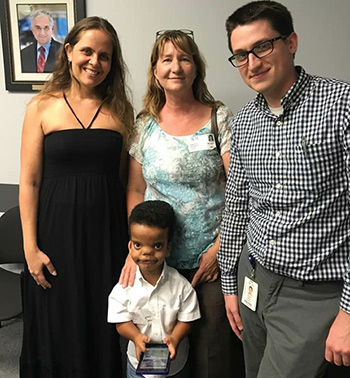 Physicians and scientists at Texas Children’s Hospital are known for treating patients with some of the most complex pediatric medical conditions. They’re also known for helping patients with some of the rarest.
Physicians and scientists at Texas Children’s Hospital are known for treating patients with some of the most complex pediatric medical conditions. They’re also known for helping patients with some of the rarest.
From July 18 to 22, 20 individuals with Robinow syndrome and their families came to Houston from across North America for the 25th Robinow Syndrome Foundation Convention and Medical Conference, which was hosted by Texas Children’s Hospital. This group of patients represented a large cohort – about 10 percent – of all currently documented cases of Robinow syndrome, an ultra-rare disorder that affects the development of many parts of the body, usually resulting in distinctive craniofacial features, skeletal and genitourinary abnormalities, and in some cases heart defects.
Because there are several genes associated with Robinow, the physical characteristics and their severity can vary between individuals, affecting their health and quality of life in different ways. To gain a better understanding of specific health needs, and to gain new insight into the genetic reasons behind the variance in symptoms, Texas Children’s physicians held a special research day as part of the conference.
The multidisciplinary effort was two years in the making and driven by the research of Texas Children’s clinical geneticist Dr. V. Reid Sutton and co-investigator, Dr. Claudia Fonseca, adjunct assistant professor of molecular and human genetics at Baylor College of Medicine, whose work together on Robinow recently garnered a grant from the Eunice Kennedy Shriver National Institute of Child Health and Human Development, part of the National Institutes of Health.
“Our work with the Robinow Syndrome Foundation two years ago led to us being able to observe differences in individuals depending on which gene was causing the disorder,” said Sutton. “We were excited to host the event this year at Texas Children’s so we could follow up on initial studies, get new samples for research, and gather more detailed information on the differences in physical symptoms in the hope that we can improve care for these patients.”
Clinical and lab space was set aside specifically for the research day. Texas Children’s Child Life Department was on hand to direct families, assist with procedures, and alleviate any stress or anxiety with activities and fun ways to pass the time. For six hours, the patients and their families met individually with teams of physicians across six different disciplines, including urology, plastic surgery, psychology, endocrinology and genetics.
In addition to collecting new samples, Sutton also measured bone density in about half the patients using DEXA (dual-energy X-ray absorptiometry) scanning and high-resolution peripheral quantitative computed tomography at the Children’s Nutrition Research Center’s Body Composition Lab. Dr. Renata Maricevich from the Department of Plastic Surgery examined patients’ craniofacial symptoms, noting the health implications of structural deformities, particularly breathing and speech problems, and how surgical options could help. Additionally, a team of pediatric urology fellows and residents, led by Dr. Paul Austin, director of Texas Children’s Complex Urologic Reconstruction program and professor of Surgery for the Department of Urology at Baylor, observed patients’ genitourinary abnormalities, which can affect both appearance and function, particularly among males with Robinow.
“I anticipate the collaborative research conducted during the conference will culminate in a landmark reference document for the treatment of Robinow,” Austin said. “The specialty-specific data will help better characterize and delineate the phenotypic features based on the mutation present. So in the case of urology, we will have a better understanding of urologic issues associated with the various genetic forms of Robinow and will be able to develop more specialized treatments.”
In addition to possible surgical interventions, findings from the research day demonstrated that there could be potential non-surgical treatment options for Robinow patients as well. Dr. Shilpi Relan from pediatric endocrinology spoke to families about growth hormone therapies, as well as the possibility of testosterone therapy for males to help mitigate, or perhaps even avoid, some of the genitourinary symptoms. Experts at Texas Children’s also addressed the potential psychological repercussions of living with Robinow. Drs. Marni Axelrad and David Schwartz from Texas Children’s Clinical and Pediatric Health Psychology assessed cognitive and fine motor strengths and weaknesses, and created behavioral and emotional profiles for individual patients.
“Texas Children’s provides fabulous support for individuals living with syndromes like Robinow and their families,” Axelrad said. “Whether they need help for emotional, behavioral or cognitive challenges, our providers work together to better understand each patient and their needs. The information gathered at this conference has the potential to help patients understand how Robinow specifically affects them, as well as providing information about potentially helpful clinical assessment and intervention.”
The event was incredibly well received by the families who attended.
“The response from our families was very positive,” said Kimberly Kremeier, executive director of the Robinow Syndrome Foundation. “The physicians at Texas Children’s took time to explain in detail their findings and potential treatment plans. Our families were pleased to get answers, and some needing treatment now have a plan of care that hadn’t been available in their local communities. We welcome future collaboration with Texas Children’s in the future.”
The multidisciplinary research team will reconvene in the coming months to compile their findings from the research day, as well as presenting subsequent ideas for treatment and therapies, into manuscripts for joint publication.
“Ultimately we want to understand all the physical manifestations of Robinow in detail, as well as correlating the genetic basis in individual patients,” Sutton said. “Knowing why we’re seeing the physical differences is going to help us improve the care we can provide.”

